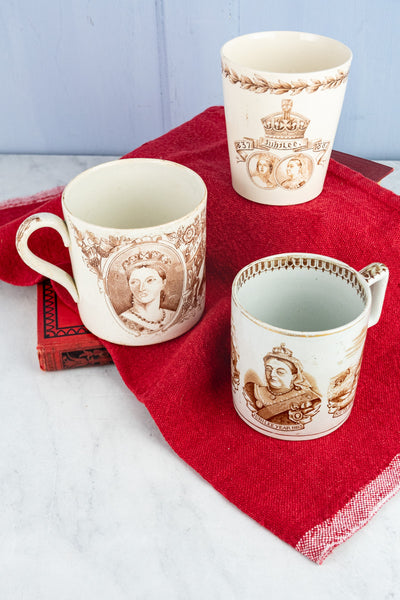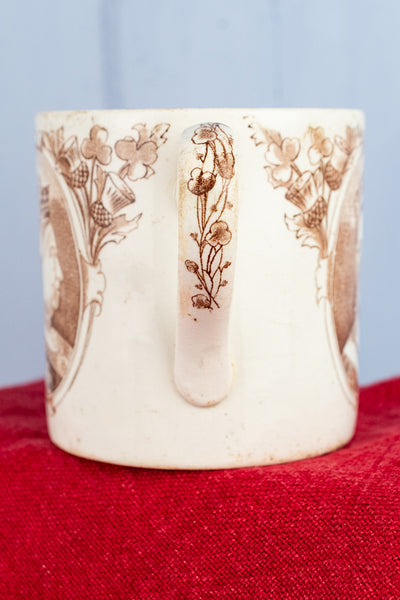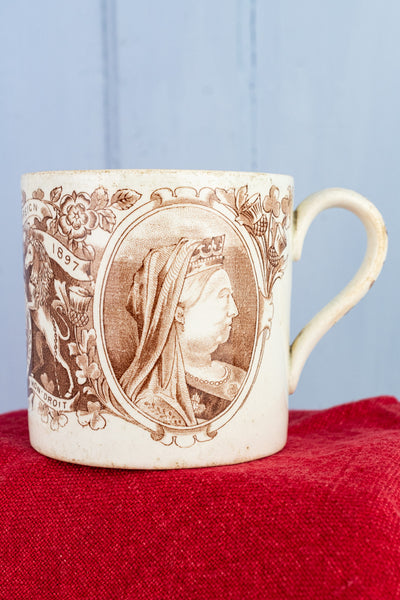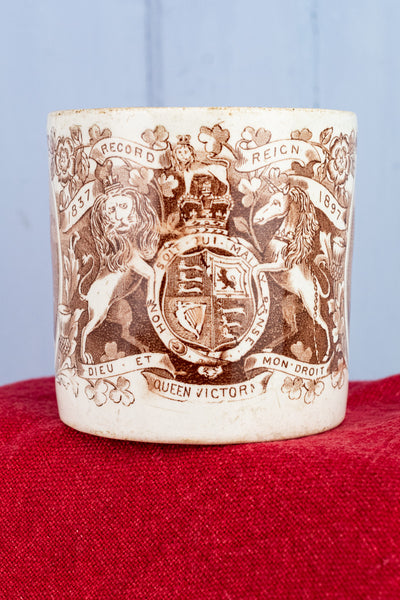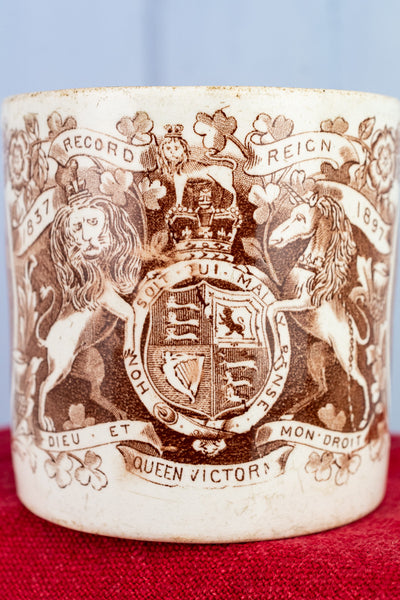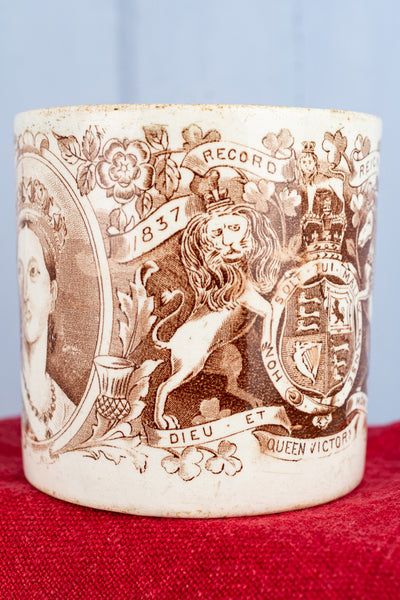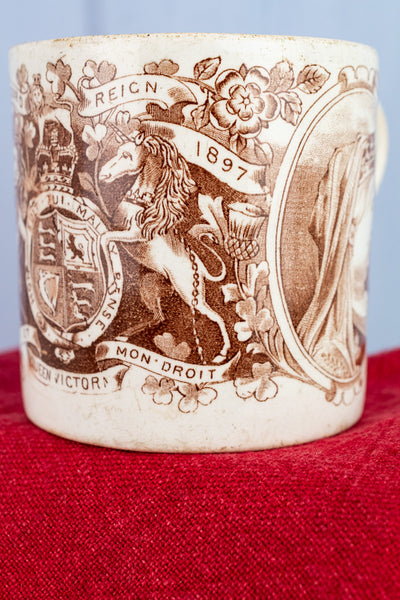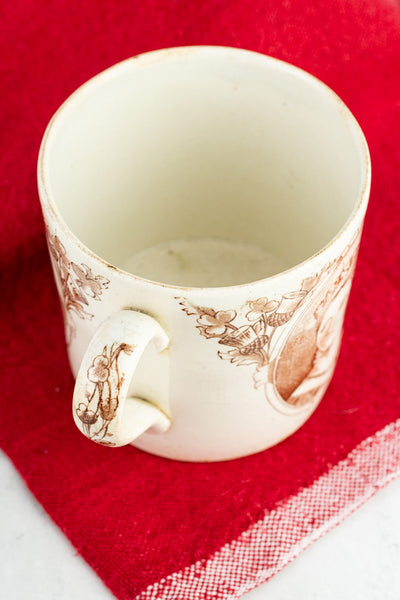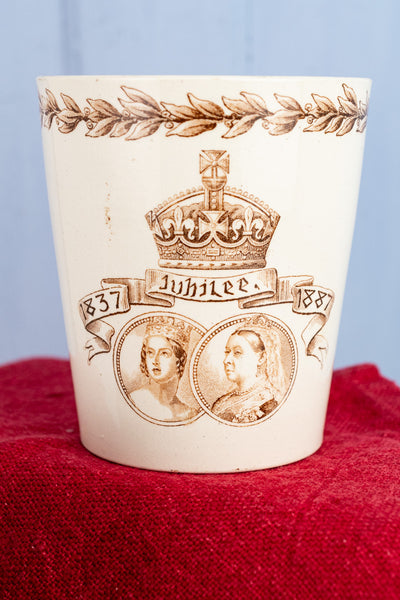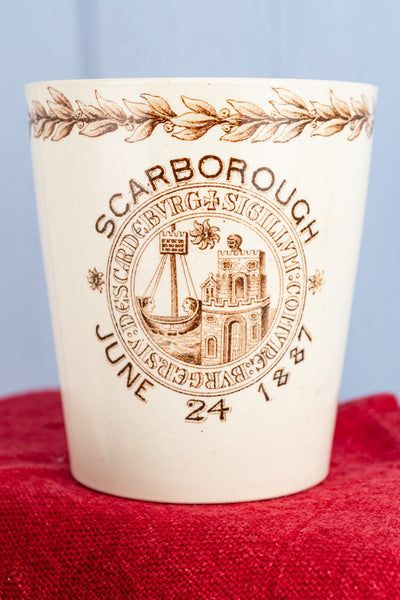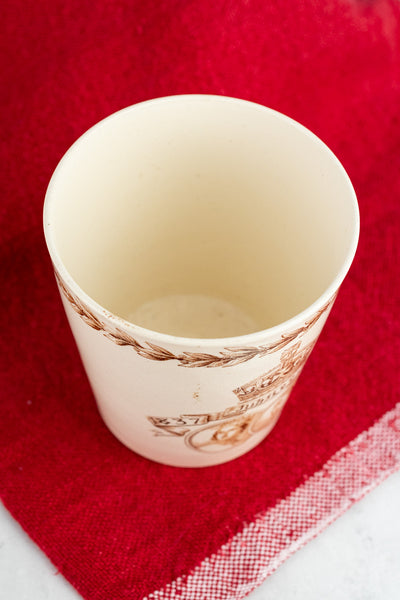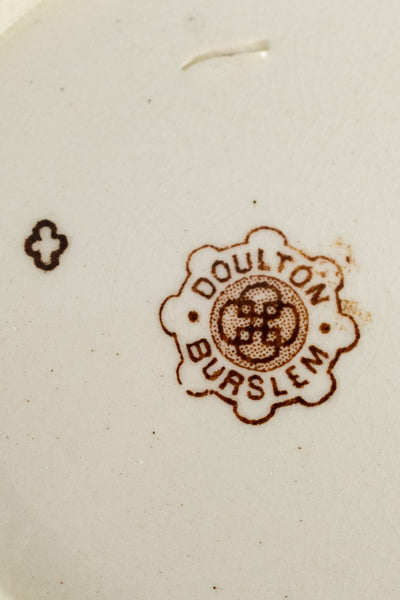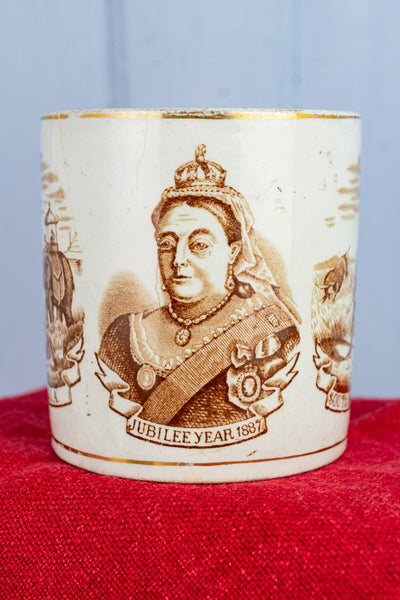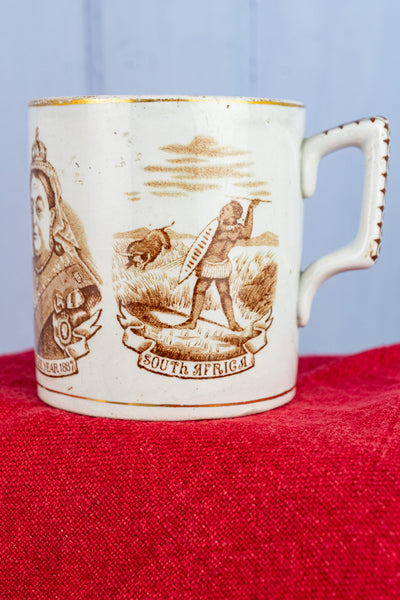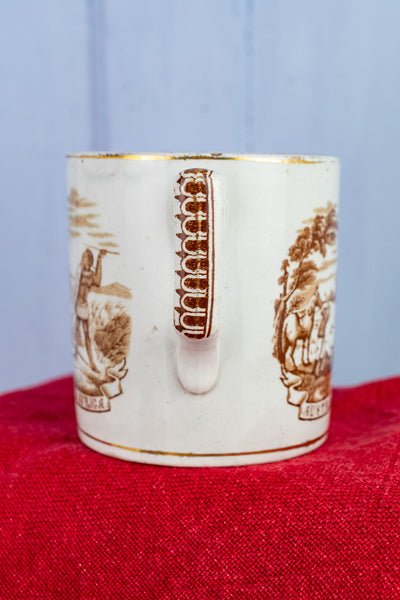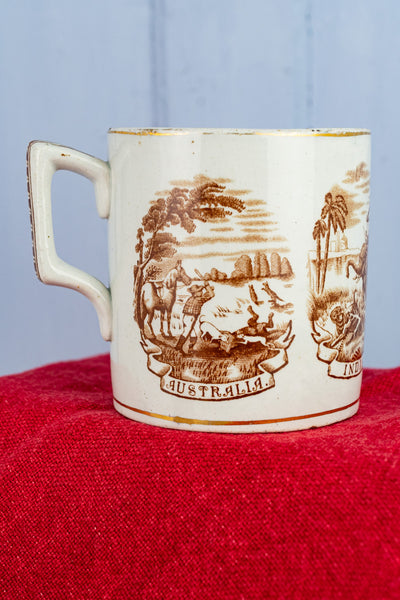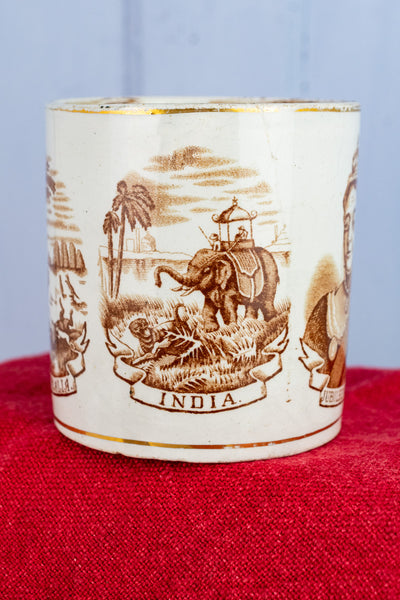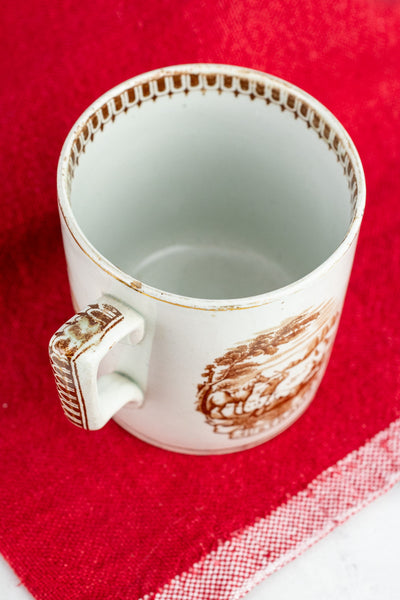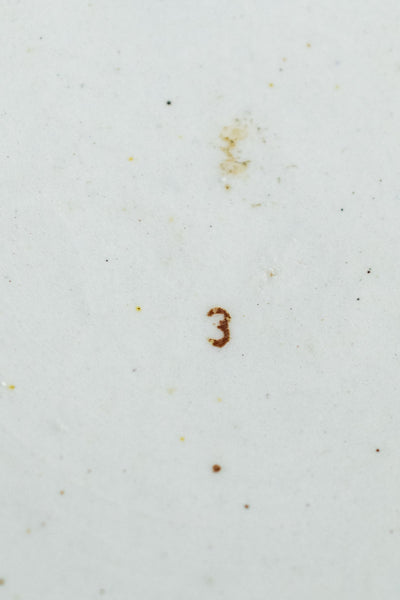Queen Victoria Jubilee Vessel
Queen Victoria Jubilee Vessel
$125.00
Produced as souvenirs to celebrate the queen's historic Jubilee years, this striking Antique Queen Victoria Jubilee Vessel with its rich sepia brown tones proclaims that a grand celebration is at hand. Discovered at market in the north of England, each of these antique cups is resplendent with national pride and symbolic renderings to commemorate significant milestones during the reign of Queen Victoria.
The highly decorative glazed cream earthenware beaker with its pair of interlinked portrait medallions was crafted for the queen's Golden Jubilee Year of 1887. Crafted in Stoke-on-Trent by noted potter, Doulton, in the years leading up to the addition of the word 'Royal' to their stamp, this delightful cup has most certainly remained a cherished collectible for nearly 140 years. With its graceful, tapered silhouette and pretty likenesses of the Queen surmounted by a regal crown and cascading sash with a dancing laurel leaf garland above, the front of the cup commemorates 50 years upon the throne '1837 VR1 1887'. On the reverse, the date 'June 24th 1887' marks the town of Scarborough's Jubilee celebration.
With its depiction of lands across the British Empire of 1887, the Golden Jubilee Mug highlights a detailed portrait of Queen Victoria interspersed with vignettes labeled 'India', 'Australia' and 'South Africa.' The Queen is featured in royal regalia as well as the "Widow's Crown" created to more easily facilitate use of the mourning veil she wore in the decades following the death of her beloved consort, Prince Albert. In this rare mug design, a banner commemorates 'Jubilee Year 1887' below the central image.
The oversized Diamond Jubilee Portrait Mug features prominent portraits of the young Queen at the time of her ascension in 1837, as well as a more mature likeness representing the Jubilee Year 1897. Oval medallions frame the images of the queen while the Royal Lion and Unicorn bridge the area between the cameos, supporting a shield of heraldic imagery.
Incorporated into the intricate design, key mottos represent both the monarchy and the Jubilee celebration of Queen Victoria - 'Record Reign 1837 1897,' 'Honi Soit Qui Mal Y Pense,' 'Dieu et Mon Droit' and 'Queen Victoria.' Crafted by noted Stoke-on-Trent potter Wagstaff & Brunt, China and Earthenware Merchants, at their King Street pottery, the brown transferware mug also depicts romantic sprays of clover, thistle, and rose.
These cheerful cups celebrating Queen Victoria are quaint examples of early royal memorabilia and promise to enliven any setting with their captivating charm.
Strictly one-of-a-kind and subject to prior sale. In very good antique condition with signs of use commensurate with age. Golden Jubilee Beaker measures 3.75"H x 4.5", Golden Jubilee Mug measures 4"H x 3.5", Diamond Jubilee Mug measures 4"H x 5.75".
Learn More About Queen Victoria
Queen Victoria was the monarch of the United Kingdom of Great Britain and Ireland from June 20, 1837 until her death on January 22, 1901. From May 1, 1876, she used the additional title of Empress of India.
Victoria was born on May 24, 1819 and was the daughter of Prince Edward, the fourth son of King George III. In a twist of fate, both her father and the King died in 1820, and Victoria was raised under close supervision by her very strict German-born mother Princess Victoria of Saxe-Coburg-Saalfeld. On June 20, 1837, Victoria's uncle King William IV died at the age of 71, and at the very young age of 18, Victoria became Queen. In her diary she wrote, "I was awoke at 6 o'clock by Mamma, who told me the Archbishop of Canterbury and Lord Conyngham were here and wished to see me. I got out of bed and went into my sitting-room (only in my dressing gown) and alone, and saw them. Lord Conyngham then acquainted me that my poor Uncle, the King, was no more, and had expired at 12 minutes past 2 this morning, and consequently that I am Queen."
The United Kingdom was already an established constitutional monarchy, in which the Sovereign held relatively few direct political powers. Privately, Victoria attempted to influence government policy and ministerial appointments. Publicly, she became a national icon, and was identified with strict standards of personal morality.
Victoria married her first cousin, Prince Albert of Saxe-Coburg and Gotha, in 1840. By all accounts a happy union, their nine children married into royal and noble families across the continent, tying them together and earning Victoria the nickname "the grandmother of Europe".
After Albert's early death in 1861, Victoria plunged into deep mourning for the remainder of her life, choosing to wear black and having a special crown fashioned that would allow her widow's cap (head veil) to remain in place for royal engagements.
The 60th anniversary of her reign, her Diamond Jubilee, was a time of joyous public celebration on June 22, 1897. Queen Victoria had surpassed her grandfather King George III as the longest-reigning British monarch on 23 September 1896, an event she marked privately at Balmoral Castle. Writing in her journal, she reflected "People wished to make all sorts of demonstrations, which I asked them not to do until I had completed the sixty years next June." The Diamond Jubilee became a historic opportunity to celebrate Victoria's status as longest-reigning monarch, in addition to marking 60 years on the throne.
On the anniversary date of her accession, 78 year-old Victoria once again reflected in her journal: "This eventful day, 1897 has opened, and I pray God to help and protect me as He has hitherto done these sixty long eventful years! I feel sad at the new losses I have sustained... God will surely help me on! How well I remember this day sixty years ago when I was called from my bed by dear Mama to receive the news of my accession!"
Until the record-setting service of Elizabeth II, Queen Victoria's reign of 63 years and seven months was the longest of any other British monarch and the longest of any female monarch in history. Still referred to today as the Victorian era, it was a period of vast industrial, cultural, political, scientific, and military change within the United Kingdom.


